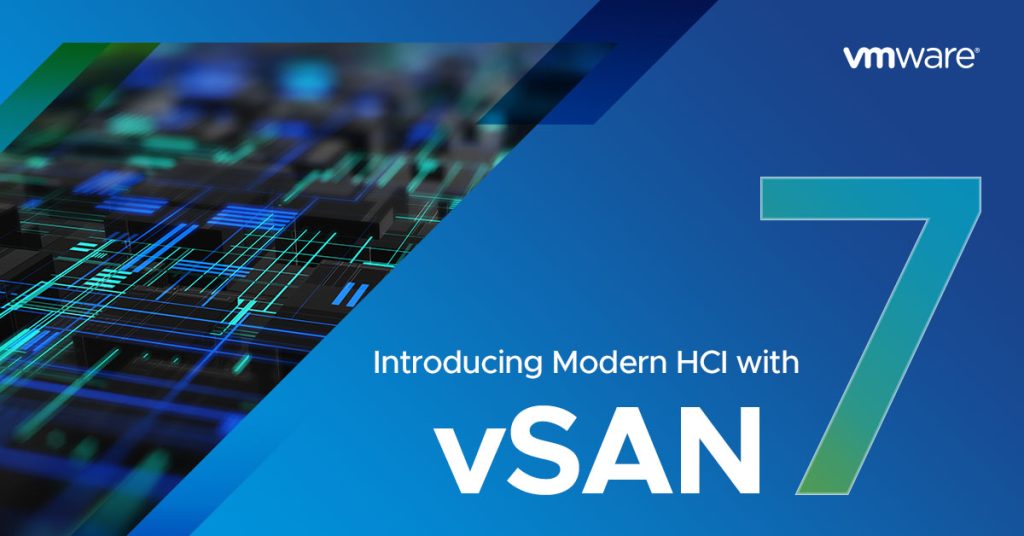VMware vSAN 7.0 (2V0-21.23)

This 24 hours course features intensive hands-on training that focuses on installing, configuring, and managing VMware vSphere® 7, which includes VMware ESXi™ 7 and VMware vCenter Server® 7. This course prepares you to administer a vSphere infrastructure for an organization of any size. This course is the foundation for most of the other VMware technologies in the software-defined data center.
Course Objectives
By the end of the course, you should be able to meet the following objectives:
- Describe the software-defined data center (SDDC)
- Explain the vSphere components and their function in the infrastructure
- Describe the benefits and capabilities of VMware Skyline
- Install and configure ESXi hosts
- Deploy and configure VMware vCenter® Server Appliance™
- Use VMware vSphere® Client™ to manage the vCenter Server inventory and the vCenter Server configuration
- Manage, monitor, back up, and protect vCenter Server Appliance
- Create virtual networks with vSphere standard switches
- Describe the storage technologies supported by vSphere
- Configure virtual storage using iSCSI and NFS storage
- Create and manage VMware vSphere® VMFS datastores
- Use the vSphere Client to create virtual machines, templates, clones, and snapshots
- Create a content library and deploy virtual machines from templates in the library
- Manage virtual machine resource use
- Migrate virtual machines with VMware vSphere® vMotion® and VMware vSphere® Storage vMotion®
- Create and manage a vSphere cluster that is enabled with VMware vSphere® High Availability and VMware vSphere® Distributed Resource Scheduler™
- Discuss solutions for managing the vSphere life cycle
- Use VMware vSphere® Lifecycle Manager™ to perform upgrades to ESXi hosts and virtual machines
Intended Audience
- System administrators
- System engineer
Prerequisites
This course has the following prerequisites:
- System administration experience on Microsoft Windows or Linux operating systems
Certifications
Attending this course meets the training requirement to achieve the following certification:
- VMware Certified Professional – Data Center Virtualization (VCP-DCV)
Course Delivery Options
- Classroom
- Live Online
- Onsite
- On Demand
Product Alignment
- VMware ESXi 7.0
- VMware vCenter Server 7.0
Course Summary
Course Fee
৳ 15,000
Training Method
Online
Total Modules
10
Course Duration
24 Hours
Total Session
12
Class Duration
2 Hours

Details Course Outlines
Module-01
Course Introduction
- Introductions and course logistics
- Course Objectives
Module-02
Introduction to vSAN
- Describe vSAN architecture
- Describe the advantages of object-based storage
- Describe the difference between All-Flash and Hybrid vSAN architecture
- Explain the key features and use cases for vSAN
- Discuss the vSAN integration and compatibility with other VMware technologies
- Identify vSAN objects and components
- Describe a vSAN object
- Describe how objects are split into components
- Explain the purpose of witness components
- Explain how vSAN stores large objects
- View object and component placement on the vSAN datastore
Module-03
Planning a vSAN Cluster
- Identify requirements and planning considerations for vSAN clusters
- Apply vSAN cluster planning and deployment best practices
- Determine and plan for storage consumption by data growth and failure tolerance
- Design vSAN hosts for operational needs
- Identify vSAN networking features and requirements
- Describe ways of controlling traffic in a vSAN environment
- Recognize best practices for vSAN network configurations
Module-04
Deploying a vSAN Cluster
- Deploy and configure a vSAN cluster using the Cluster QuickStart wizard
- Manually configure a vSAN cluster using vSphere Client
- Explain and configure vSAN fault domains
- Using VMware vSphere® High Availability with vSAN
- Understand vSAN cluster maintenance capabilities
- Describe the difference between implicit and explicit fault domains
- Create explicit fault domains
Module-05
vSAN Storage Policies
- Explain how storage policies work with vSAN
- Explain the role of storage policies in planning a vSAN cluster
- Define and create virtual machine storage policies
- Apply and modify virtual machine storage policies
- Change virtual machine storage policies dynamically
- Change virtual machine storage policies dynamically
Module-06
Introduction to Advanced vSAN Configurations
- Define and configure compression and deduplication in the vSAN cluster
- Define and configure encryption in the vSAN cluster
- Understand the remote vSAN datastore topology
- Identify the operations involved in managing the remote vSAN datastore
- Configure the vSAN iSCSI target service
Module-07
vSAN Stretched and Two-Node Clusters
- Describe the architecture and use cases for stretched clusters
- Detail the deployment and replacement of a vSAN witness node
- Describe the architecture and use cases for two- node clusters
- Explain the benefits of vSphere HA and VMware Site Recovery Manager™ in a vSAN stretched cluster
- Explain storage policies for vSAN stretched cluster
Module-08
vSAN Cluster Monitoring
- Describe how the Customer Experience Improvement Program (CEIP) enables
- VMware to improve products and services
- Use vSphere Skyline Health for monitoring vSAN Cluster Health
- Manage alerts, alarms, and notifications related to vSAN in vSphere Client
- Create and configure custom alarms to trigger vSAN health issues
- Use IO Insight metrics for monitoring vSAN performance
- Analyse vsantop performance metrics
- Use vSAN Proactive Test to detect and diagnose cluster issues
Module-09
Native vSAN File Service
- Discuss the use cases for vSAN file service
- Understand the high-level architecture of vSAN file service
- Discuss the authentication model
- Configure file shares
- Monitor file share health and capacity utilization
Module-10
vSAN Cluster Maintenance
- Perform typical vSAN maintenance operations
- Describe vSAN maintenance modes and data evacuation options
- Assess the impact on cluster objects of entering maintenance mode
- Determine the specific data actions required after exiting maintenance mode
- Define the steps to shut down and reboot hosts and vSAN clusters
